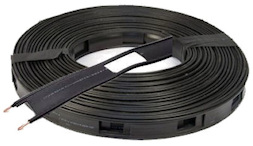|

300-ohm ladder line is a type of balanced transmission line often used in amateur radio, television antennas, and some professional RF applications. Below are the typical specifications, power handling, and other details:
Specifications
- Impedance:
- 300 ohms (nominal, balanced).
- Material:
- The conductors are typically made of copper or copper-clad steel.
- The insulators are generally made of polyethylene or similar materials.
- Spacing:
- The two conductors are held apart by a uniform dielectric spacing, maintaining the 300-ohm impedance.
- Loss Characteristics:
- Lower loss than coaxial cable over similar distances, especially at higher frequencies.
- Loss depends on the quality of the material, frequency, and length.
Power Handling
- Power Ratings:
- 300-ohm ladder line can typically handle hundreds of watts of RF power.
- High-quality ladder line can handle up to 1,000 watts or more, depending on the spacing and insulation material.
- Factors Influencing Power Handling:
- Dielectric Breakdown: The insulation must resist high voltages caused by high RF power.
- Heating: Larger conductor sizes allow for greater current capacity and less heating.
Advantages
- Low Loss: Ladder line has significantly lower loss than coaxial cable, especially at high frequencies, because of its open-air dielectric and balanced design.
- Flexibility: It can be used for long runs with minimal signal degradation.
- Wide Matching Range: Ideal for use with antenna tuners, allowing operation across a wide range of frequencies.
Applications
- Feeding multi-band dipole or Yagi antennas.
- Use in amateur radio for high-efficiency transmission.
- Broadcasting and TV antenna systems.
If you need detailed specifications for a particular manufacturer or application, let me know!
|
|
|